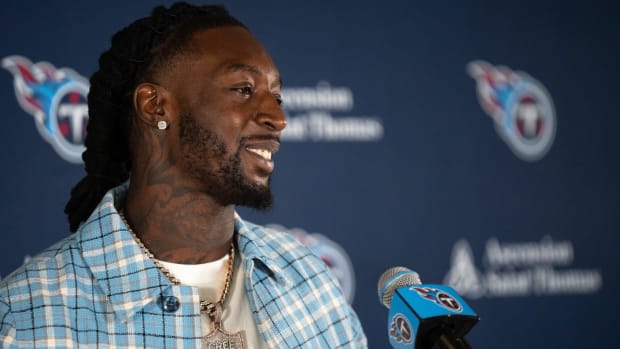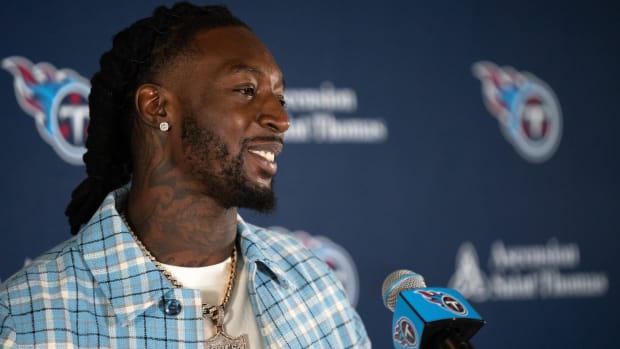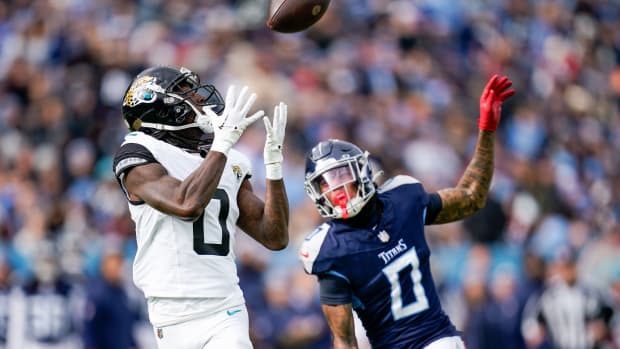2024 NFL Draft: WR Prospects For the Jaguars to Watch
Which wide receivers should the Jaguars have their eyes on in two weeks?
Heading into the 2024 season, it’s safe to say that the Jaguars wide receiver group still sits among the middle of the pack. Despite losing Calvin Ridley, the addition of Gabe Davis alleviates the immediate need for an outside receiver. Christian Kirk and Zay Jones have proven to be solid weapons, but they battled injuries throughout most of the season.
In recent years, several young wide receivers (Jamarr Chase, Justin Jefferson, Amon-Ra St. Brown) have become All-Pro’s before reaching the end of their rookie contract. This draft, the Jaguars can capitalize on another loaded wide receiver class rather than breaking the bank in free agency.
Xavier Worthy (Texas)
If only Al Davis were here to see this. Using a first-round pick on the draft’s fastest player is nearly a guaranteed recipe for disaster. But after three All-Big 12 seasons at Texas, Worthy proved that he should be viewed as more than just a gadget player.
If you don't know by now, Worthy broke the NFL Combine’s 40 yard dash record with a time of 4.21 seconds. As a true freshman, he broke several school records, including freshman receiving touchdowns in a season (12) and receiving yards (981). He was named the Big-12 Offensive Freshman of The Year and earned Freshman All-American honors. In his final season at Texas, he hauled in 75 passes for 1014 yards.
Worthy’s most impressive characteristic isn’t just his speed, it’s his ability to tame it. What separates Worthy from most speedsters is his savvy route-running. Defensive backs are immediately threatened by his speed, which often causes them to flip their hips and bail on the route early. The former Longhorn leaves defenders with little time to recover by efficiently getting out of his breaks in three to four steps. Although his slight frame tempts defenders to lunge at him in press coverage, he utilizes a variety of release techniques (split, diamond, slide) that make it difficult to get a hand on him.
His flexibility allows him to be laterally explosive, which effectively complements his record-breaking straight-line speed. His speed also sticks out while running slants, outs and double-moves. In the off-season, he works out with Delfonte Diamond, a self-proclaimed “route-running specialist”. Diamond also trains players like Ceedee Lamb, Stefon Diggs, Jaylen Waddle, and the Jaguars own Parker Washington.
Players that run in the 4.2-4.3 range tend to have a limited catch radius, usually relying on deep balls and screen passes. However, Worthy’s ability to track the ball in the air while adjusting his body proves that he can be a valuable asset from any part of the field. His impressive coordination helps him make tough catches in traffic, despite being undersized (5 foot 11, 170 pounds).
Occasionally, Worthy struggles with concentration as a pass-catcher. Instead of following the football with his eyes until he makes the catch, Worthy can get overly-excited and take off running before properly securing the ball. Although he rarely struggled while using his hands to catch a pass, he is most comfortable as a “body-catcher”. In college, he gained enough separation to effectively square up and corral the ball into his chest/stomach. At the professional level, he will not have as much room to work with.
Malachi Corley (Western Kentucky)
During his time at Western Kentucky, Malachi Corley was the heart and soul of their football program. He left the program as their career leader in receptions (259) and second all-time in receiving touchdowns (29). He’s acknowledged that he would have been a hot commodity in the transfer portal, but he preferred to show loyalty toward the program that recruited him when others wouldn’t.
As the focal point of Western Kentucky’s offense, Corley was targeted often and usually immediately. His team’s offensive strategy was to get the ball in his hands as quickly as possible. This was executed through a variety of screens, hitches and jet sweeps. While Corley had the chance to show off his dynamic playmaking ability, his route tree was limited. With that being said, his tendency to create separation during 1 on 1 competition at the Senior Bowl showed that he is comfortable with a variety of concepts outside of the most basic ones.
Corley lined up in the slot 67% of the time, and was tight to the formation 12% of the time. At 5 foot 11 and 215 pounds, his stocky frame helps him hang on to passes in traffic after being hit by linebackers and safeties. As a slot receiver, the former Hilltopper was also asked to run a lot of seam/bender routes into the middle of the field. These are some of the toughest catches to make, but Corley pulls them off effortlessly. If a pass is thrown behind him, Corley does a solid job at adjusting and flipping his hips without having to fall to the ground.
The 2-time First Team All Conference-USA selection turns into a running back with the ball in his hands. He is incredibly efficient as a ball-carrier, knowing when to lower his shoulder, make a cut or simply take off up-field at the right time.
The level of talent that Corley usually faced wasn’t as competitive as other high-ranked prospects. When he got the chance to compete against teams for larger conferences, he proved that he was just as gifted as anybody on the field. Against Auburn, he hauled in 12 passes, finishing with 110 yards from scrimmage. Against Ohio State, Corley caught 8 passes for 88 yards and a touchdown.
Corley isn't as light on his feet as most high-rated receivers under 6 feet. Although he has polished footwork and doesn't struggle to move laterally, he’s just not astoundingly agile. He makes up for this by being heavier and stronger than most slot receivers. His build makes it difficult for defensive backs to stay in front of him, both as a route-runner and as a ball-carrier.
Xavier Legette (South Carolina)
Legette might be the most intriguing wide receiver prospect in this year's draft. If he left South Carolina after four years, he likely wouldn’t have been on any teams draft board (42 catches, 5 touchdowns from 2019-2022). After using his extra year of eligibility, Legette finished with 1,255 receiving yards, the second-most in the SEC.
At 6 foot 3 and 230 pounds, Legette’s build resembles an outside linebacker more than a wide receiver. His size advantage is quite obvious, but there also aren’t many players that can keep up with his speed. While racing to the end-zone for a 76-yard touchdown against Mississippi State, he was clocked at 22.3 miles-per-hour. At that point of the season, it was the fastest time in the NCAA and NFL. For reference, Tyreek Hill’s 23.24 mph run was the fastest recorded time in NFL history. On deep routes like posts and corners, Legette’s first few steps are explosive enough to immediately create 2-3 yards of separation from defensive backs.
The former Gamecock has remarkable body control for a player his size. His ability to smoothly contort his body in mid-air with a defender draped over him makes him a threat at all times. During the rare instances that a defender actually keeps up with him, he eventually creates space by using his brute strength. Legette incorporates “chop” and “rip” techniques to discreetly push defenders away without being called for offensive pass interference.
Although he was almost exclusively used as an outside receiver, he typically lined up with a reduced split (closer to the offensive line, rather than out wide). His size and power helps him be an effective blocker, he was often asked to block an outside linebacker or even seal an edge rusher.
While Legette was a late bloomer as a wide receiver, he has been dynamic on special teams since he was a true freshman. One of the highlights of his career was a 100 yard kickoff return touchdown against Texas A&M, on the opening play of the game. Everybody learns at a different pace, and NFL playbooks are notoriously complicated. With that being said, Legette’s eye-opening athleticism and commitment to his own development indicate that he will eventually be a key contributor at the next level.
Ladd McConkey (Georgia)
At Georgia, McConkey was often overshadowed by Brock Bowers, who is projected to be a top-15 pick in this year's draft. During Georgia’s 2022 National Championship season, McConkey was their second leading receiver. He ended the year with 896 yards from scrimmage and 7 total touchdowns. In the National Championship Game, he caught 2 touchdowns and finished with 88 receiving yards.
In 2023, Georgia threw the ball less, which led to a decreased output from McConkey. He caught 30 passes for 478 yards and 2 touchdowns. Whether he got the ball or not, his film proved that he will give defensive backs nightmares at the next level.
The former Bulldog has the ideal frame for a slot receiver (5 foot 11, 190 pounds), with the speed (4.39 40 yard dash) to also line up on the outside. He does a great job at “selling” routes with his eyes and shoulders without breaking stride and slowing down his footwork. We often hear about quarterbacks making pre-snap reads, but receivers must do this as well. Based on the defense’s alignment, McConkey knows which track he should take to efficiently reach the finishing point of his route.
Even as an outside receiver, he is most comfortable when lining up off the ball against the press. The extra yard or two of space allows him to “set up” defenders, and make them miss. The 2022 Second-Team All SEC selection doesn’t waste any time with the ball in his hands. As one of the fastest players on the field, he seems to understand that it's usually best for him to knife upfield and rack up as many yards as possible.
At times, he takes poor angles when attempting to bring in passes further down the field. He is not dramatically undersized, but his path to the ball makes him struggle to gain positioning. He has the athleticism to be a vertical threat, but he needs to become more comfortable “playing the outfield” and tracking down deep balls.





